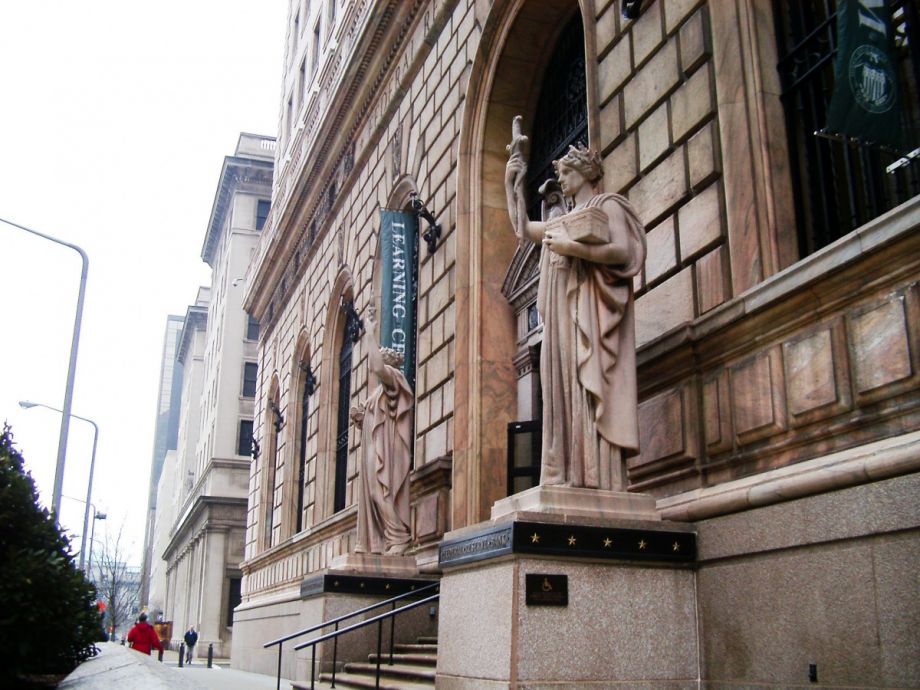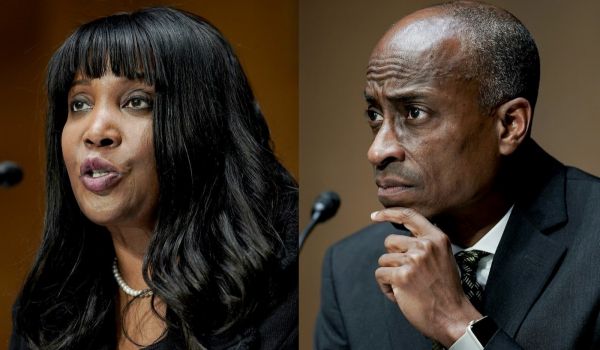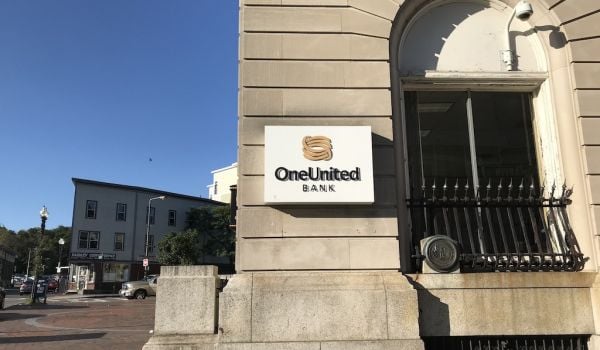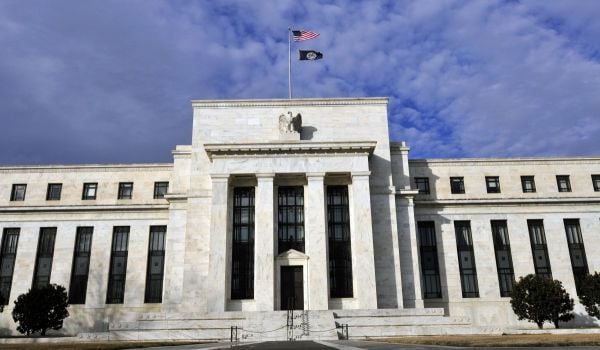Claudia Sahm first came to work at the Fed just as the world started crumbling — back in 2007, at the beginning of the financial crisis that eventually pulled the whole world into the Great Recession.
Like most of her new colleagues, Sahm had just been recruited from academia to join the 400 or so other Ph.D. economists who work at the offices of the Federal Reserve Board of Governors in Washington, D.C. They analyze economic data and offer up insights and analysis to advise the Federal Open Market Committee, or FOMC, the most important decision-making body of the Federal Reserve.
Every six weeks, the FOMC meets to debate and make decisions on monetary policy — including whether to raise interest rates, lower them, or hold them at current levels. It’s the most significant way the Fed influences the economy — lowering interest rates promotes growth by encouraging households to take out loans to buy homes, cars, appliances or other major purchases. It also encourages more businesses to take out loans to expand and potentially hire new workers. Raising interest rates discourages all the above.
In the weeks leading up to each meeting, Sahm and her hundreds of colleagues compiled their analyses and insights into the “Report to the FOMC on Economic Conditions and Monetary Policy.” It’s nicknamed the “Tealbook,” for the color of the stripes on its cover. For all the years it took for the economy to recover from the Great Recession, when Sahm was among this elite squad of economists, there was a particularly glaring omission from their analysis — racial disparities in unemployment.
“Through the entire crisis and recovery we never put a chart in front of the Board of Governors with the Black-white unemployment rate,” Sahm told me in an interview. “Never. You kinda know certain groups are always hit harder in a recession, but it’s different when you stare at a line. We didn’t do that, they never saw that, they only ever saw the national employment rate.”
But during the recovery from this pandemic, the Fed is doing things differently. The minutes for the last FOMC meeting, in early November, explicitly mention that “the unemployment rates for African Americans and Hispanics also declined over this period, but both rates remained well above the national average.”
In a recent feature story for Next City, I wrote in-depth about some of the forces behind the recent changes at the Fed. Those forces would like people to start paying more attention to the Fed, including when the FOMC is in session — like this week, today and tomorrow to be exact, when the FOMC is meeting for the eighth and final time this year.
“The combination of the financial crisis a decade ago and now the pandemic and the Fed’s response to those crises made it very clear, if we want to have an impact on economic policy, we can’t ignore the Fed,” Saqib Bhatti, co-director of the Action Center on Race and the Economy, said to me. “It’s one of the most powerful economic policymaking institutions in the world and we don’t spend enough time thinking about it.”
The FOMC consists of the seven members of the Federal Reserve Board of Governors — nominated by the President and confirmed by the U.S. Senate — plus five of the presidents of the 12 Federal Reserve Regional Banks. The other seven regional bank presidents also attend the committee meetings and participate in the conversations but they don’t get to vote as committee members on what action to take. Four of the five voting presidents rotate in and out every year, with the president of the New York Fed president always getting one of those seats.
That set of people has been the target of the “Fed Up Campaign,” launched about a decade ago by the progressive organizing group Center for Popular Democracy. For too long, the campaign says, the FOMC has sacrificed employment and wage increases for the sake of fighting against inflation. Since the late 1970s, Congress has charged the Fed with what’s known as the “dual mandate” to support both price stability and full employment, but usually, of these two competing priorities, price stability wins out.
While inflation isn’t to be taken lightly as a threat to low-income households, the downsides of the Fed’s approach have hit some communities harder than others — Black and brown neighborhoods that chronically face unemployment rates twice that of white neighborhoods; or hard-hit low-income white communities particularly in Rust Belt cities or rural areas still dealing with long-term effects of deindustrialization.
The Fed Up Campaign argues having a wider array of viewpoints, more representative of the country as a whole, would help provide some missing balance to the FOMC’s decision-making. A July 2021 report from the Fed Up Campaign found only limited progress over the past few years. The Fed’s senior leadership — members of the Fed’s board of governors and bank presidents — are 100% white and 83% white respectively.
“People tend to think about unemployment like the weather, it’s good or bad but nothing you can do about it,” says Benjamin Dulchin, who currently leads the Fed Up Campaign. “It’s too big to wrap your mind around. But to a large extent it is a policy decision by 12 people sitting around a table in Washington every six weeks. The fact is they’ve done that without really considering the proper impact of long-term unemployment on Black and brown people and on wage stagnation for everyone.”
With three seats to fill on the Federal Reserve’s Board of Governors over the next few months, the Biden-Harris Administration has the chance right now to dramatically shift those numbers at the central banking system’s highest level.
“The Federal Reserve is supposed to represent the broad population and they have to understand the broad population to represent those interests,” Dulchin says. “A diverse Fed is not just about symbolic representation, it’s about having leaders at the Fed actually understanding what the needs of the economy are.”
There has been limited progress at other levels of Fed leadership. Among the regional Federal Reserve Bank Boards of Directors, which play a key role because they help select each bank’s president, 66% are white and 56% are men, according to the Fed Up Campaign report. That diversity has led to some changes at the regional level, although the Federal Reserve banks don’t currently have much to do with regard to monetary policy — they mostly help supervise banks and do a lot of research.
The Federal Reserve Bank of Atlanta made history in 2017 when its directors appointed Raphael Bostic as the first Black person to serve as president of any Federal Reserve bank. He’s since used his position as a platform to speak out about racial disparities in the economy and to argue that the Fed has a role to play in closing those disparities.
Other regional banks of the Federal Reserve have also ramped up statements and programming around racial equity. The Minneapolis Fed launched its Opportunity & Inclusive Growth Institute in 2017. Just this year the St. Louis Fed launched its Institute for Economic Equity.
That statistic you might have heard about Boston’s Black households having a median net worth of just $8 compared to $247,500 for white households — that was research published by the Boston Fed. The San Francisco Fed published a study of racial wealth disparities in Los Angeles, using the same methodology and some of the researchers as the Boston study.
The San Francisco Fed also published research in April showing how the economy would gain $2.6 trillion in GDP if racial and gender disparities were eliminated in terms of earnings, hours worked, educational attainment, and employment.
All 12 Federal Reserve regional banks have been collaborating to produce an ongoing discussion series on racism and the economy.
Supporting research on racism in the economy and holding discussions about it has helped influence discussions and shift perspectives across the Federal Reserve system, Sahm says, but those discussions remain strikingly monochromatic.
In February, the New York Times reported that only two of the 417 economists on staff at the Federal Reserve Board of Governors in Washington were Black. Meanwhile, of the 870 economists working at Federal Reserve regional banks around the country, just 11 were Black, along with 82 Hispanic or Latino and 146 of Asian descent.
“There’s not a lot of diversity of background, or diversity of viewpoints,” Sahm says. “The staff come out of many of the same universities, with the same training…rowing all the same direction does have some benefits. There’s not chaos before every FOMC meeting. But it creates blind spots.”
Some say the pipeline is to blame — and they’re not entirely wrong. The economics profession has long had a problem attracting and retaining people of color. Black graduates make up less than 4% of the U.S. citizens and permanent residents who obtain a Ph.D. in economics each year. But that said, there is nothing that says the Fed may only hire analysts with an academic background in economics. But the Fed has fielded questions from Congress about diversifying its staff economists since at least the 1990s, and the numbers are still what they are.
Sahm points to the Fed’s peculiar hiring and promotion patterns as one area worth closer examination. New Fed economists generally get hired at the research assistant level or junior economist level, as she was, and they get promoted when more senior economists retire, take other government positions, or succumb to the lure of a huge salary bump on Wall Street. So the only place new Fed economists really come into the institution is at the bottom. Intentionally or not, it’s been an effective way to keep out more diverse professionals from staying on staff at the Fed long enough to shift the numbers.
“You’re bringing people who don’t look like the rest of the room at the very bottom of the food chain and the people up above in the food chain have never had to act respectfully with people who don’t look like them,” Sahm says.
Change at the Fed is a slow crawl to be sure, but it’s always taken a combination of outside pressure and legislation from Congress to make it happen. Congress gave the Fed its dual mandate in the late 1970s, as part of the tail end of the civil rights era, but activists say that mandate wasn’t fully implemented until this past year as there has been more pressure from activists as well as from Congress on the Fed to take full employment more seriously.
If more people don’t pay attention to the Fed, Dulchin says, the Fed’s worldview will be dominated by the Wall Street bankers who interact with it directly on a daily basis.
“It’s the Fed’s secret power to hide in plain sight by using economic jargon,” Dulchin says. “So no one understands them but the financial sector so they’re the only ones that have had access.”
This article is part of The Bottom Line, a series exploring scalable solutions for problems related to affordability, inclusive economic growth and access to capital. Click here to subscribe to our Bottom Line newsletter.

Oscar is Next City's senior economic justice correspondent. He previously served as Next City’s editor from 2018-2019, and was a Next City Equitable Cities Fellow from 2015-2016. Since 2011, Oscar has covered community development finance, community banking, impact investing, economic development, housing and more for media outlets such as Shelterforce, B Magazine, Impact Alpha and Fast Company.
Follow Oscar .(JavaScript must be enabled to view this email address)


















